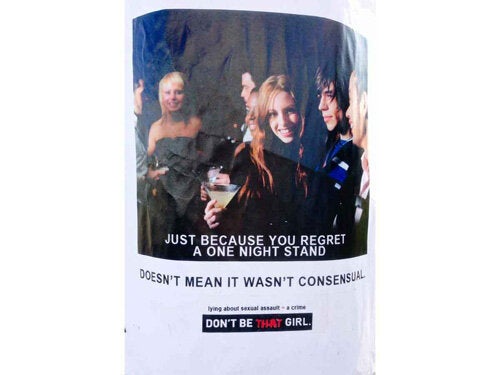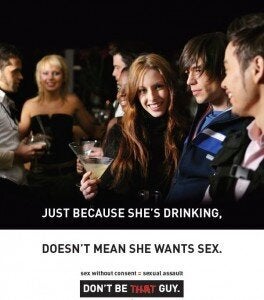A group in Edmonton is sounding the alarm about what it suggests are rampant false rape reports. Advocacy group Men's Rights Edmonton recently plastered the University of Alberta campus with posters that entreat the reader, "Don't Be That Girl."

According to Men's Rights Edmonton, "that girl" is a woman who has consensual sex that she later falsely reports as rape, in order to cope with emergent feelings of regret or shame. The sentiment rests on a commonly held belief in the men's rights community -- namely, that countless women are hell-bent on ruining the lives of former sexual partners by falsely reporting them to the police as rapists. Proponents of this argument are fond of citing a statistic from a 1994 study by Professor Eugene Kanin that determined 41 per cent of rape reports to a Midwestern U.S. police agency over a nine-year period were false. If this number were credible, that would indeed be a sorry state of affairs.
Thankfully, Kanin's study has been thoroughly debunked [pdf] as lacking any kind of methodological rigour. He simply took police officers' determinations at face value, rather than following the standard academic practice of actually investigating these determinations and analyzing them in context. His sample was also a piddling 109 cases -- not a large enough sample size to hang one's hat on, really. Rigorous studies put the percentage of false reports anywhere between 2-8 per cent (some studies have put it as low as 0.6 per cent), which is less than the number of falsely reported auto thefts. Yet do we question the credibility and, indeed, the sanity of people who report their cars stolen?
Police officers' own determinations about sexual assault cases lack reliability and validity, to put it mildly. Police agencies in the U.S. and the U.K. have come under scrutiny for intimidating rape survivors into recanting their statements. Police suspicion and intimidation impact all kinds of survivors, but some are even more likely to face harsh scrutiny from law enforcement: in particular women of colour, trans women, indigenous women, sex workers and women living with mental illness or disabilities. The percentages of rape cases that go unreported (54 per cent), do not result in an arrest (88 per cent), do not undergo prosecution (91 per cent) and do not lead to a felony conviction (95 per cent) are jaw-dropping. Obviously most law enforcement is not champing at the bit to arrest and/or lay charges on alleged rapists. So who are all these "that girls" that Men's Rights Edmonton is so determined to stop?
The posters' placement on a university campus is especially problematic because post-secondary campuses tend to have high rates of acceptance when it comes to rape myths. One study [pdf] clocked the percentage of rapes that college students believe to be false at 50 per cent. When one out of every four or five female college students are raped, the perpetuation of these kinds of myths is legitimately dangerous.

Credit: Sexual Assault Voices of Edmonton (SAVE)
To add insult to injury, the posters' design and branding borrow liberally (and quite obviously, intentionally) from the successful "Don't Be That Guy" campaign. "Don't Be That Guy" takes a novel approach to curbing sexual assault by depicting scenarios in which rapes often occur (e.g. a girl is passed out on a couch at a party) and using the bro-friendly phrase "don't be that guy" to discourage the violation of consent. "Don't Be That Guy" originated in Edmonton as a project of Sexual Assault Voices of Edmonton (SAVE), and has since been adopted throughout Canada, the U.S., New Zealand and Australia. Vancouver police credited the campaign with contributing to a 10 per cent year-over-year reduction in citywide sexual assaults.
When it comes to the human right to safety and freedom, anecdotal evidence just won't cut it, nor will shoddy research. "Don't Be That Guy" is a campaign that addresses a well-documented problem whose roots and impacts are supported by decades of methodologically rigorous research. There are, sadly, many "that guys" that the campaign is speaking to. My question is: who's "that girl" that Men's Rights of Edmonton wants to reach? The evidence suggests she's more of a straw woman than they might be willing to admit.
